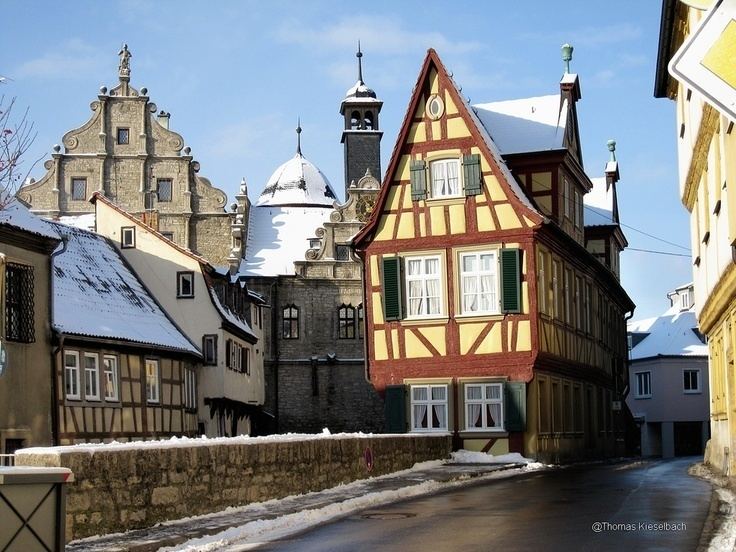Admin. region Unterfranken Municipal assoc. Marktbreit Area 20.15 km² Population 3,603 (31 Dec 2008) Administrative region Lower Franconia | Elevation 191 m (627 ft) Local time Monday 12:08 PM Dialling code 09332 | |
 | ||
Weather 9°C, Wind SE at 8 km/h, 50% Humidity | ||
Marktbreit germany from the air blade 350qx2 fpv sj4000
Marktbreit am Main is a town in the district of Kitzingen in the Regierungsbezirk Unterfranken in Bavaria, Germany. It is situated at the most southern point of the Main river. Marktbreit is the birthplace of Alois Alzheimer who first identified the symptoms of what is now known as Alzheimer's Disease. With its suburb Gnodstadt, Marktbreit has around 3,700 inhabitants.
Contents
- Marktbreit germany from the air blade 350qx2 fpv sj4000
- Map of 97340 Marktbreit Germany
- Location
- Subdivisions
- Neighbouring communities
- Roman settlement
- Later history
- Government
- Attractions
- Transport
- Education
- References
Map of 97340 Marktbreit, Germany
Location
The town of Marktbreit is located in the district of Kitzingen, in the Lower Franconia region of Bavaria. Its territory lies on the left bank of the Main river, at the river's southernmost bend. The town of Kitzingen lies upriver, while downriver are Ochsenfurt and Würzburg.
Marktbreit is located on the southwestern edge of the district, where it borders on the districts of Neustadt (Aisch)-Bad Windsheim and Würzburg.
Subdivisions
The town has two Stadtteile: Marktbreit and Gnodstadt.
Neighbouring communities
The municipality borders on (from the north clockwise): Marktsteft, Obernbreit, Martinsheim, Oberickelsheim, Ochsenfurt, Frickenhausen am Main and Segnitz.
Roman settlement
Near Markbreit, the site of a large Roman legionary fortress (or castrum legionarium) known locally as the Römerlager Marktbreit, was discovered in 1985 and celebrated as a minor scientific sensation because it was never suspected that a legionary fortress was built so far north in enemy territory. It was built in Augustan times in enemy territory beyond the "Limes" frontier in preparation for an invasion of the rest of Germany.
It was identified on aerial photos in 1985, and archaeologists were active in 1986-1992. They discovered a remarkable place, because the palisade (2¼ km long, using 21,000 trees) appeared to be finished and several buildings were complete. The surface area of 37 ha suggested that the base was built for two legions or one legion and many auxiliary troops. There were no traces of actual occupation and it took some time to conclude that this was not the result of erosion, but from the fact that the base had been prepared but was never used.
The headquarters (praetorium), the residences of three centurions, store rooms (horrea), and kilns had already been finished before the settlement was abandoned. There are no traces of violence, and precious objects appear to have been taken away, which suggests that Marktbreit was evacuated when strategic realities had changed and made it unnecessary.
However, a rebellion in Pannonia delayed the execution of the invasion plan, and the defeat of Varus in the Teutoburg Forest put an end to all Roman ambitions east of the Rhine, and the base was never used.
Later history
Gnodstadt was first mentioned in a document in 1124. Marktbreit was first mentioned as "broite inferior" in a document of the Count of Castell in 1258. From 1351 Gnodstadt was ruled by Hohenlohe-Brauneck. In 1557, King Ferdinand granted Marktbreit the right to hold markets, thus the name "Markt"breit that has since been used.
In the 17th and 18th century Marktbreit was an important marketplace because the shortest way to the Danube from the Main (which flows into the Rhine) starts in Marktbreit.
In 1806, Marktbreit came to the Kingdom of Bavaria.
Gnodstadt became a part of Marktbreit on 1 May 1978.
Government
The town is a member of and the seat of the municipal association Marktbreit.
The town's mayor is Erich Hegwein (CSU).
Attractions
See also List of Marktbreit monuments (German)
Transport
The Bundesautobahn 7 passes through the municipal territory, as does Bundesstraße 13.
Marktbreit has a station on the railway line Treuchtlingen–Würzburg. In the summer, it is also a stop for tourist ships travelling on the Main.
Education
Marktbreit has three kindergartens, a Grundschule, Mittelschule, Realschule and a Gymnasium.
